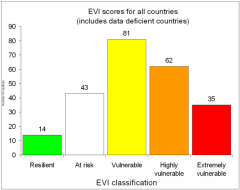 The EVI is based on 50 indicators for estimating the vulnerability of the environment of a country to future shocks. These indicators are combined by simple averaging and reported simultaneously as a single index, a range of policy-relevant thematic sub-indices and as a profile showing the results for each indicator. Simple averages across indicators were used because they can be easily understood and more complex models do not appear to offer any advantages to the expression or utility of the index. This overview with drill-down structure means that in addition to an overall signal of vulnerability, the EVI can be used to identify specific problems. The EVI has been designed to reflect the extent to which the natural environment of a country is prone to damage and degradation. It does not address the vulnerability of the social, cultural or economic environment, nor the environment that has become dominated by those same human systems (such as cities and farms) because these are included in the economic and social vulnerability indices which are needed separately to identify trade-offs.
The EVI is based on 50 indicators for estimating the vulnerability of the environment of a country to future shocks. These indicators are combined by simple averaging and reported simultaneously as a single index, a range of policy-relevant thematic sub-indices and as a profile showing the results for each indicator. Simple averages across indicators were used because they can be easily understood and more complex models do not appear to offer any advantages to the expression or utility of the index. This overview with drill-down structure means that in addition to an overall signal of vulnerability, the EVI can be used to identify specific problems. The EVI has been designed to reflect the extent to which the natural environment of a country is prone to damage and degradation. It does not address the vulnerability of the social, cultural or economic environment, nor the environment that has become dominated by those same human systems (such as cities and farms) because these are included in the economic and social vulnerability indices which are needed separately to identify trade-offs.
 Therefore, the natural environment includes those biophysical systems that can be sustained without direct and/or continuing human support. The environment at risk includes ecosystems, habitats, populations and communities of organisms, physical and biological processes (such as beach building and reproduction), productivity and energy flows, diversity at all levels, and interactions among them all. Each of these ecosystem goods, services and relationships may be affected by natural and human hazards, the risk of which may vary with time, place and human choices and behaviour. The indicators used are ‘smart’ or end-point indicators, selected because they signal a wide variety of conditions and processes that must be operating well if that measure is favourable in terms of environmental vulnerability. Smart indicators are a way of minimising data requirements while providing a good characterisation of environmental vulnerability. For example, the presence in a country of a high percentage of original forest cover automatically indicates that all the processes that lead to maintenance of good cover must be operating well for that end-point to be present, without the need to measure the many hundreds of indicators that could individually lead to losses. The conditions present may include good policies for preservation, low widespread degradation, sufficient renewable water recharge, and little problem with acid rain.
Therefore, the natural environment includes those biophysical systems that can be sustained without direct and/or continuing human support. The environment at risk includes ecosystems, habitats, populations and communities of organisms, physical and biological processes (such as beach building and reproduction), productivity and energy flows, diversity at all levels, and interactions among them all. Each of these ecosystem goods, services and relationships may be affected by natural and human hazards, the risk of which may vary with time, place and human choices and behaviour. The indicators used are ‘smart’ or end-point indicators, selected because they signal a wide variety of conditions and processes that must be operating well if that measure is favourable in terms of environmental vulnerability. Smart indicators are a way of minimising data requirements while providing a good characterisation of environmental vulnerability. For example, the presence in a country of a high percentage of original forest cover automatically indicates that all the processes that lead to maintenance of good cover must be operating well for that end-point to be present, without the need to measure the many hundreds of indicators that could individually lead to losses. The conditions present may include good policies for preservation, low widespread degradation, sufficient renewable water recharge, and little problem with acid rain.
 There are three distinct aspects of vulnerability recognisable for environmental, economic and social aspects of countries, all of which need to be evaluated to provide an overall sense of the issues at play. These are the risks associated with hazards, resistance and acquired vulnerability (damage). The first aspect relates to the likelihood of hazards coming into play, while the latter two aspects are related to the ability of the environment to withstand the effects of hazards. In the EVI, indicators were specifically selected to ensure that information on these three aspects is incorporated in the overall vulnerability of countries. There are 32 indicators of hazards, 8 of resistance and 10 that measure damage. The hazard indicators relate to the frequency and intensity of hazardous events. The resistance indicators refer to the inherent characteristics of a country that would tend to make it more or less able to cope with natural and anthropogenic hazards. This includes measures such as absolute size (there are fewer options for refuges in small countries) and number of shared borders (there are greater risks of trans-boundary effects). Damage indicators relate to the vulnerability that has been acquired through loss of ecological integrity or increasing levels of degradation of ecosystems. The underlying assumption is that the more degraded the ecosystems of a country (as a result of past natural and anthropogenic hazards), the more vulnerable it is likely to be to future hazards. Indicators were also selected to ensure a good spread of information across the different elements that comprise and/or affect ecosystems. Indicators on weather & climate (6 indicators), geology (4), geography (6), ecosystem resources & services (28) and human populations (6) were chosen to ensure a good cross-section of the ecological processes, including human interactions occurring in countries.
There are three distinct aspects of vulnerability recognisable for environmental, economic and social aspects of countries, all of which need to be evaluated to provide an overall sense of the issues at play. These are the risks associated with hazards, resistance and acquired vulnerability (damage). The first aspect relates to the likelihood of hazards coming into play, while the latter two aspects are related to the ability of the environment to withstand the effects of hazards. In the EVI, indicators were specifically selected to ensure that information on these three aspects is incorporated in the overall vulnerability of countries. There are 32 indicators of hazards, 8 of resistance and 10 that measure damage. The hazard indicators relate to the frequency and intensity of hazardous events. The resistance indicators refer to the inherent characteristics of a country that would tend to make it more or less able to cope with natural and anthropogenic hazards. This includes measures such as absolute size (there are fewer options for refuges in small countries) and number of shared borders (there are greater risks of trans-boundary effects). Damage indicators relate to the vulnerability that has been acquired through loss of ecological integrity or increasing levels of degradation of ecosystems. The underlying assumption is that the more degraded the ecosystems of a country (as a result of past natural and anthropogenic hazards), the more vulnerable it is likely to be to future hazards. Indicators were also selected to ensure a good spread of information across the different elements that comprise and/or affect ecosystems. Indicators on weather & climate (6 indicators), geology (4), geography (6), ecosystem resources & services (28) and human populations (6) were chosen to ensure a good cross-section of the ecological processes, including human interactions occurring in countries.
For most indicators, signals are based on average levels observed over the past 5 years, but may include data for much longer periods for geological events. The indicators signal risk potentials based on the experience of the immediate past because these are the influences most likely to affect short-term trends in environmental vulnerability and how ecosystems may respond to hazards compared with the years preceding them. This does not imply that that there are no effects of older events, only that the EVI has been designed to focus on this time frame. With repeated evaluations, the EVI will demonstrate changes in otherwise longer-term processes. The outcome of this strategy will be an understanding that for a while after an event, vulnerability to future hazards is elevated. The short timeframe also allows improvements to be measured quickly for indicators that can be directly influenced by human action.
All of the EVI’s indicators are transformed to a common scale so that they can be combined by averaging, and to facilitate the setting of thresholds of vulnerability. This new scale has been designed to reflect the environmental vulnerability associated with each indicator, regardless of any other scale on which an indicator could simultaneously exist. The EVI scale was defined as ranging between a value of 1 (indicating high resilience / low vulnerability) and 7 (indicating low resilience / high vulnerability). The EVI scale was determined separately for each indicator, is designed to be policy- relevant, and is based on the best available scientific information.


